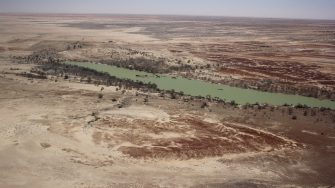
Date: Monday, October 13, 2014
Project: Eastern Australian Waterbird Survey
Observer: Richard Kingsford
With the rising sun behind us, we flew west along Band 8. Dry river and creek beds run north to south across the survey band. The last good rainfall out here was in May and many of the landholders have moved their cattle elsewhere as a big dry has set in.
Once again we cross the Diamantina River; it now has double the number of channels across its wide floodplain. From up high, coolabah-lined channels look like giant green braids across the brown landscape.
Photo 1. Cattle converge on these waterholes, sending up clouds of dust
Here, Pelican Waterhole lived up to its name with its flotillas of pelicans. It is one of the few watering places in this dry land for stock.
Photo 2. Pelican waterhole on the Diamantina River
Next west to one of my favourite river systems, the King Creek-Eyre Creek system. Today, its water was confined to the main channels thick with aquatic plants. Today – it looked like a creek. But floods turn it into a mighty river, with vast floodplains and lakes. Like Cooper Creek, this massive system was named a creek because the early explorers met it in dry times. Eyre Creek takes northern floodwaters west and then down through the edge of the Simpson Desert sand dunes to join the Diamantina River down to Lake Eyre. The bright blue water of Pippigitta Waterhole is stunning, probably reflecting the minerals in the water.
Video – Surveying Pippigitta waterhole
Lake Mipia reflects the sun, the only substantial water in any direction. It is one of the lakes supplied by Eyre Creek holds water where thousands of waterbirds now concentrate.
Photo 3. Lake Mipia on Eyre Creek is particularly shallow but still provides habitat for thousands of waterbirds
We finish surveying Band 8 and head south to refuel in Birdsville and then eastward along Band 7. Once again we meet the Diamantina, another 200 kilometres south of the morning’s crossing. This is the start of Goyder’s lagoon, a swamp which stretches for about thirty kilometres but it is dry. There is only water in the waterholes, such as Andrewilla Waterhole – just the odd pelican, egret and cormorant.
Photo 4. The large waterhole on the Diamantina River at Birdsville
We pass by the braided streams off the hills, running into Cooper Creek, the next river east.
Photo 5. Streams take water off local hills into Cooper Creek
We pass by Lake Yamma Yamma, a lifeless flat dry lake bed – very different from the floods in 2010-2011 when there were flocks of pelicans trawling its freshwaters for their colony. It is fed by the Cooper which, like all these rivers, was just a string of waterholes. Each with its small complement of pelicans, cormorants, herons and the odd duck. I was caught mid count by what I thought was a large cormorant sitting on a log until I realised it was a large turtle. Many of these individuals are up to 80 years old with the deeper waterholes having the oldest turtles. Shallow waterholes dry out and so turtles that move there during the floods die. Today was very different from the flood years when there were hundreds of thousands of waterbirds throughout these rivers and floodplains.
Photo 6. Waterhole on Cooper Creek
Map of Day 6, the 12th of October
